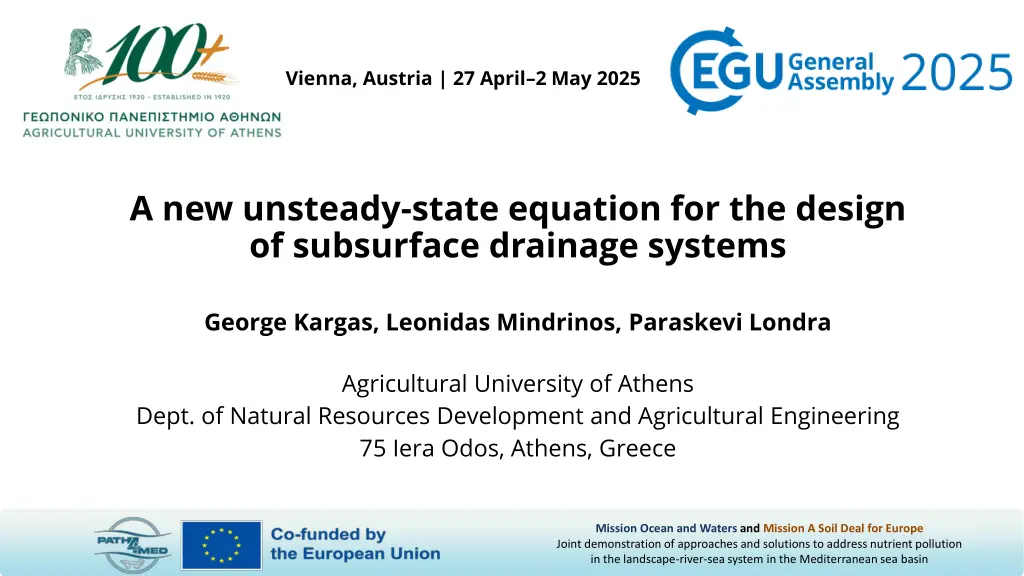
Unsteady-State Equation for Design of Subsurface Drainage Systems
Explore a new unsteady-state equation for designing subsurface drainage systems to enhance soil aeration, promote crop growth, and maintain soil productivity. The study presents mathematical formulations, boundary conditions, and a linearized solution using the Variational Iteration Method. Discover how to estimate drain spacing for optimal water removal efficiency.
Download Presentation

Please find below an Image/Link to download the presentation.
The content on the website is provided AS IS for your information and personal use only. It may not be sold, licensed, or shared on other websites without obtaining consent from the author. If you encounter any issues during the download, it is possible that the publisher has removed the file from their server.
You are allowed to download the files provided on this website for personal or commercial use, subject to the condition that they are used lawfully. All files are the property of their respective owners.
The content on the website is provided AS IS for your information and personal use only. It may not be sold, licensed, or shared on other websites without obtaining consent from the author.
E N D
Presentation Transcript
Vienna, Austria | 27 April2 May 2025 new unsteady-state equation for the design of subsurface drainage systems George Kargas, Leonidas Mindrinos, Paraskevi Londra Agricultural University of Athens Dept. of Natural Resources Development and Agricultural Engineering 75 Iera Odos, Athens, Greece Mission Ocean and Waters and Mission A Soil Deal for Europe Joint demonstration of approaches and solutions to address nutrient pollution in the landscape-river-sea system in the Mediterranean sea basin
The artificial removal of excess surface and subsurface water from the root zone aims to enhance soil aeration and temperature, thereby promoting crop growth and maintaining soil productivity. In the present study, a new unsteady-state equation for calculating the drain spacing of subsurface drainage systems is presented. ?? ??? ?? = ??? We consider the one-dimensional Boussinesq [1] equation: (1) ?? ?? for groundwater table, K is the saturated hydraulic conductivity, and S the specific yield for a homogeneous soil. ? ?,0= ? +? ? ,0 < ? < ? ? 0,? = ? ?,? = ?,? > 0 ?? ?? ? 0<x<L and t>0, where L is the drain spacing (m) and t the time. Z(x,t) is the transient for initial and boundary conditions: (2) 2,? = 0,? > 0 where D describes the distance of the drains (placed at x=0 and x=L) from the impervious layer. The function f(x) can be constant, polynomial or trigonometric (Figure 1).
We assume the following equation: ? ? = ?0??? ?? ? (3) Figure 1. The geometry of the drainage problem. ? 2 From Eq. (3) we observe that ? 0 = ? ? = 0 and ? = 0 so that the boundary conditions ? 2 ? 2,0 = ? + ?0. in Eq. (2) are satisfied and in addition ? = ?0resulting in ?
The Eq. (1) is a nonlinear partial differential equation (PDE), and we linearize it under the following assumptions. We rewrite Eq. (1) as 2 ?2? ??2= 0 ? ?? ?? 1 ? ?? (4) ?? ?? If Z is relatively large, and the slope?? ??is small, the second term can be neglected. In addition, we replace Z in the first fraction by its mean value ? = ? +?0 diffusion-type PDE of the form 2, to obtain a linear ?? ?? ??2? ??2= 0 (5) where ? =?? ?
We propose to solve it using the Variational Iteration Method [3] which provides the solution in a series form and converges after a few iterations. Performing two iterations, we get the following equation ? 1 ???2 ??2?+?2?2?4 ?2 ?,? = ? +?0??? ?? 2?2?4?2 (6) We observe that this solution satisfies both initial and boundary conditions (Eq. 2) ?2? 2,0= ? +?0 ?20,? = ? ?2 ?,? = ? ??2 ??? (7) 2,? = 0 The representation (6) will be considered as the approximated solution of the linearized Eq. (5). An interesting problem is to estimate the spacing L between the drains given the height decrease in the middle, for a specific time interval. Specifically, find L from the following equation (8) ,? = ?+ ? ?2 ? 2 for some given time T>0 and height m<m0.
Substituting x=L2 and t=T in Eq. (6) we get ? + ?01 ???2 ??2? +?2?2?4 (9) 2?2?4?2= ? + ? resulting in a quadratic equation for L2. From the two positive solutions of the quadratic Eq. (9) for L2, the acceptable solution is given by (10) which is valid only if 2? ?0> 0 ? >?0 height m in the middle is bigger or equal than its half initial value m0. , meaning the above formula is applicable when the 2 The comparison of the proposed equation with the widely used Glover-Dumm [2] equation showed relative error differences smaller than 5%.
References 1. Boussinesq, J. (1903), Sur le d bit, en temps de s cheresse, d'une source aliment e par une nappe d'eaux d'infiltration, C. R. Hebd. Seanc. Acad. Sci. Paris, 136, 1511 1517. 2. Dumm, L. D. (1954) Drain spacing formulas. Agric Eng ASAE 35,726-730. 3. He, J. H. (1997) Variational iteration method for delay differential equations. Communications in Non-linear Science and Numerical Simulation. 2 (4), 235-236. Mission Ocean and Waters and Mission A Soil Deal for Europe Joint demonstration of approaches and solutions to address nutrient pollution in the landscape-river-sea system in the Mediterranean sea basin






















